高三英语阅读课教案范文集锦
- 格式:docx
- 大小:27.48 KB
- 文档页数:27
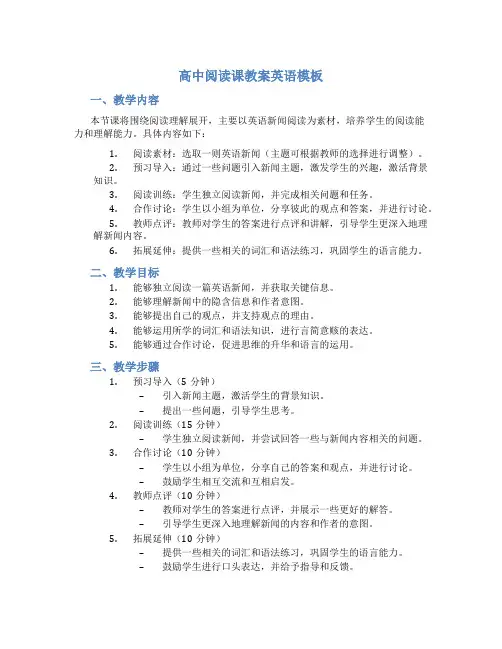
高中阅读课教案英语模板一、教学内容本节课将围绕阅读理解展开,主要以英语新闻阅读为素材,培养学生的阅读能力和理解能力。
具体内容如下:1.阅读素材:选取一则英语新闻(主题可根据教师的选择进行调整)。
2.预习导入:通过一些问题引入新闻主题,激发学生的兴趣,激活背景知识。
3.阅读训练:学生独立阅读新闻,并完成相关问题和任务。
4.合作讨论:学生以小组为单位,分享彼此的观点和答案,并进行讨论。
5.教师点评:教师对学生的答案进行点评和讲解,引导学生更深入地理解新闻内容。
6.拓展延伸:提供一些相关的词汇和语法练习,巩固学生的语言能力。
二、教学目标1.能够独立阅读一篇英语新闻,并获取关键信息。
2.能够理解新闻中的隐含信息和作者意图。
3.能够提出自己的观点,并支持观点的理由。
4.能够运用所学的词汇和语法知识,进行言简意赅的表达。
5.能够通过合作讨论,促进思维的升华和语言的运用。
三、教学步骤1.预习导入(5分钟)–引入新闻主题,激活学生的背景知识。
–提出一些问题,引导学生思考。
2.阅读训练(15分钟)–学生独立阅读新闻,并尝试回答一些与新闻内容相关的问题。
3.合作讨论(10分钟)–学生以小组为单位,分享自己的答案和观点,并进行讨论。
–鼓励学生相互交流和互相启发。
4.教师点评(10分钟)–教师对学生的答案进行点评,并展示一些更好的解答。
–引导学生更深入地理解新闻的内容和作者的意图。
5.拓展延伸(10分钟)–提供一些相关的词汇和语法练习,巩固学生的语言能力。
–鼓励学生进行口头表达,并给予指导和反馈。
四、教学辅助器材1.英语新闻素材(可打印或投影展示)。
2.学生问题和任务的答题纸。
五、教学评估1.阅读理解问题的答案和学生的表达能力。
2.合作讨论中学生的参与度和分享观点的能力。
3.拓展延伸中学生对词汇和语法的运用情况。
六、教学反思本节课通过英语新闻阅读训练,旨在提高学生的阅读理解和表达能力。
提供预习导入的问题,能够激发学生的兴趣和思考,帮助他们更好地理解新闻的背景和主题。
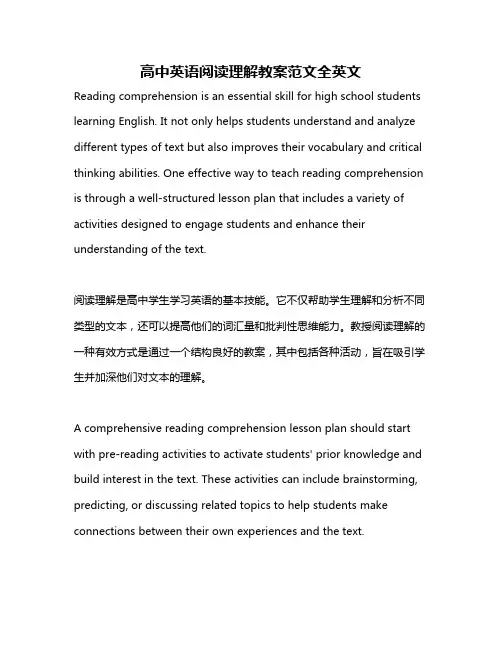
高中英语阅读理解教案范文全英文Reading comprehension is an essential skill for high school students learning English. It not only helps students understand and analyze different types of text but also improves their vocabulary and critical thinking abilities. One effective way to teach reading comprehension is through a well-structured lesson plan that includes a variety of activities designed to engage students and enhance their understanding of the text.阅读理解是高中学生学习英语的基本技能。
它不仅帮助学生理解和分析不同类型的文本,还可以提高他们的词汇量和批判性思维能力。
教授阅读理解的一种有效方式是通过一个结构良好的教案,其中包括各种活动,旨在吸引学生并加深他们对文本的理解。
A comprehensive reading comprehension lesson plan should start with pre-reading activities to activate students' prior knowledge and build interest in the text. These activities can include brainstorming, predicting, or discussing related topics to help students make connections between their own experiences and the text.一个全面的阅读理解教案应该从阅读前活动开始,激发学生的先验知识,建立对文本的兴趣。
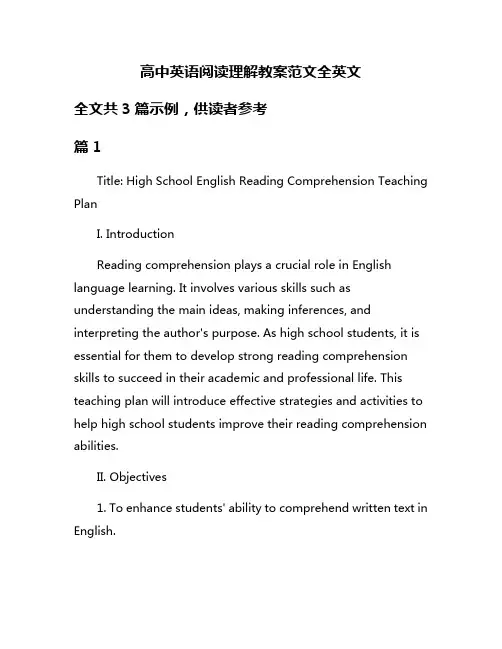
高中英语阅读理解教案范文全英文全文共3篇示例,供读者参考篇1Title: High School English Reading Comprehension Teaching PlanI. IntroductionReading comprehension plays a crucial role in English language learning. It involves various skills such as understanding the main ideas, making inferences, and interpreting the author's purpose. As high school students, it is essential for them to develop strong reading comprehension skills to succeed in their academic and professional life. This teaching plan will introduce effective strategies and activities to help high school students improve their reading comprehension abilities.II. Objectives1. To enhance students' ability to comprehend written text in English.2. To improve students' critical thinking skills through reading.3. To help students analyze and interpret different types of texts.4. To expand students' vocabulary and language proficiency.5. To develop students' confidence in reading and interpreting complex texts.III. Strategies1. Pre-reading Activities: Before reading a text, students can engage in activities such as predicting the content based on the title or images, discussing their prior knowledge on the topic, or brainstorming questions they have about the text.2. During-reading Activities: While reading, students can highlight key information, identify the main ideas and supporting details, and monitor their understanding by summarizing the text after each paragraph or section.3. Post-reading Activities: After reading, students can engage in discussions about the text, share their opinions and interpretations, answer comprehension questions, or write a summary or reflection on what they have read.4. Vocabulary Building: Introducing new vocabulary words and idioms from the text, and providing opportunities for students to use these words in context through exercises or discussions.5. Critical Thinking Exercises: Encouraging students to analyze the author's purpose, make inferences, identify biases, and evaluate the credibility of the information presented in the text.IV. Sample Lesson PlanTitle: Understanding Non-Fiction TextsObjective: To help students develop skills in comprehending and analyzing non-fiction texts.1. Warm-up (10 minutes)- Discuss the difference between fiction and non-fiction texts.- Brainstorm examples of non-fiction texts such as newspaper articles, essays, and scientific reports.2. Pre-reading Activity (10 minutes)- Show students the title and subtitles of a non-fiction article.- Ask students to make predictions about the content based on the title and subtitles.3. Reading (30 minutes)- Ask students to read the non-fiction article individually.- Encourage students to highlight key information, identify the main ideas and supporting details.- Monitor students' progress and provide support as needed.4. Post-reading Activities (20 minutes)- Divide students into small groups to discuss the main ideas of the text and share their interpretations.- Ask students to answer comprehension questions about the text.- Have students write a summary or reflection on what they have learned from the article.5. Vocabulary Building (10 minutes)- Introduce new vocabulary words from the text and discuss their meanings and usage.- Provide exercises for students to practice using the new words in sentences.6. Critical Thinking Exercise (10 minutes)- Ask students to analyze the author's purpose and identify biases in the text.- Discuss the credibility of the information presented and encourage students to form their own opinions.V. ConclusionBy implementing effective strategies and activities in teaching reading comprehension, high school students can improve their language skills, critical thinking abilities, and confidence in reading and interpreting complex texts. This teaching plan provides a framework for educators to help students develop the necessary skills to succeed in their academic and professional endeavors.篇2High School English Reading Comprehension Teaching PlanI. IntroductionReading comprehension is a vital skill for high school students to develop, as it not only enhances their academicperformance but also improves their overall language proficiency. This teaching plan aims to effectively teach high school students how to improve reading comprehension skills.II. Objectives1. To enhance students' ability to understand and interpret various types of texts.2. To improve students' vocabulary and language usage.3. To develop critical thinking skills through reading and analyzing texts.4. To help students draw connections between texts and real-life situations.III. Strategies1. Pre-reading activities: Before reading a text, engage students in activities such as brainstorming, predicting, and activating prior knowledge. This helps set the context for the text and prepares students for what they are about to read.2. During-reading activities: While students are reading a text, encourage them to use active reading strategies such as highlighting key information, making annotations, and askingquestions. This helps students stay focused and ensures better comprehension.3. Post-reading activities: After reading a text, have students engage in activities such as summarizing, analyzing, discussing, and interpreting the text. This helps reinforce comprehension and allows students to reflect on the text.IV. Lesson Plan1. Introduction to reading comprehension: Start the lesson by explaining the importance of reading comprehension and its relevance to academic success. Provide examples of how reading comprehension skills can be applied in various contexts.2. Pre-reading activity: Choose a text that is appropriate for the students' proficiency level and interests. Engage students in a pre-reading activity such as predicting the content of the text based on the title or images.3. During-reading activity: Ask students to read the text individually or in pairs and actively engage with the text by highlighting key information, making annotations, and asking questions.4. Post-reading activity: Have students discuss the text in groups, summarize the main ideas, analyze the text's structure,and draw connections to real-life situations. Encourage students to express their opinions and interpretations of the text.V. AssessmentAssess students' reading comprehension skills through various methods such as quizzes, writing assignments, class discussions, and presentations. Provide constructive feedback to help students improve their comprehension skills.VI. ConclusionReading comprehension is a crucial skill that high school students need to develop to succeed academically and in life. By implementing effective teaching strategies and engaging students in various activities, educators can help students improve their reading comprehension skills and become better readers and critical thinkers.篇3High School English Reading Comprehension Lesson PlanObjective:- To improve students' comprehension skills through reading and answering questions based on a variety of texts.- To develop students' critical thinking skills by analyzing and interpreting information from different sources.- To enhance students' vocabulary and grammar skills by exposing them to a range of reading materials.Materials:- A selection of reading passages on various topics (e.g. news articles, short stories, poems)- Reading comprehension questions for each passage- Highlighters or colored pens for marking important information- Answer keys for the comprehension questions- Whiteboard and markers for class discussionProcedure:1. Warm-up (10 minutes):- Begin the lesson by asking students to discuss in pairs or small groups about what reading comprehension means to them.- Engage the students in a short discussion about the importance of being able to understand and interpret written texts.2. Introduction to the Lesson (5 minutes):- Explain to the students that today's lesson will focus on improving their reading comprehension skills through various activities.- Provide an overview of the objectives and outcomes of the lesson to set the students' expectations.3. Reading and Comprehension Activities (40 minutes):- Divide the students into small groups and distribute the reading passages and comprehension questions.- Instruct the students to read the passage carefully, highlighting or underlining important information as they go.- Encourage students to work together in their groups to answer the comprehension questions, referring back to the text for evidence and support.- Walk around the classroom, monitoring the students' progress and providing assistance where needed.- Once the groups have completed the questions, reconvene as a class to discuss the answers and address any areas of confusion or misunderstanding.- Review the correct answers with the class and reinforce key vocabulary and grammar concepts that were covered in the passages.4. Extension Activities (15 minutes):- To further enhance the students' comprehension skills, provide additional reading passages or texts for them to work on individually or in pairs.- Encourage students to write short summaries or reflections on the texts they have read, focusing on the main ideas and key points.- Challenge the students to identify and analyze different perspectives or interpretations within the text, promoting critical thinking and analysis skills.5. Closure (5 minutes):- Conclude the lesson by reviewing the key concepts and skills that were covered during the class.- Encourage students to continue practicing their reading comprehension skills by reading regularly and engaging with a variety of texts.- Provide positive feedback and reinforcement to motivate the students and reinforce their learning.Assessment:- Assess students' comprehension skills through their responses to the reading comprehension questions and their participation in class discussions.- Monitor students' progress over time by evaluating their ability to analyze and interpret texts effectively.- Provide feedback and guidance to help students improve their reading comprehension skills and achieve their learning goals.Overall, this lesson plan is designed to help high school students develop and enhance their reading comprehension skills through engaging and interactive activities. By providing a variety of reading materials and opportunities for discussion and analysis, students will be able to improve their comprehension abilities and become more proficient readers.。

高中英语阅读理解教案范文全英文(中英文版)High School English Reading Comprehension Lesson Plan Template Below is a sample lesson plan for high school English teachers aiming to enhance their students" reading comprehension skills.This plan incorporates various strategies and activities to foster a deeper understanding of the text.Section 1: IntroductionObjective: To introduce the topic and engage students in the reading process.Activity: Begin the class by discussing the title and cover of the text.Encourage students to make predictions about the content based on these elements.Materials: Textbook, whiteboard, markers"Good morning, everyone! Today, we will embark on a journey through a fascinating text.Before we dive in, let"s take a moment to analyze the title and cover.What do you think this story is about? Share your predictions with your neighbors."Section 1:导入目标:引入话题并激发学生在阅读过程中的兴趣。
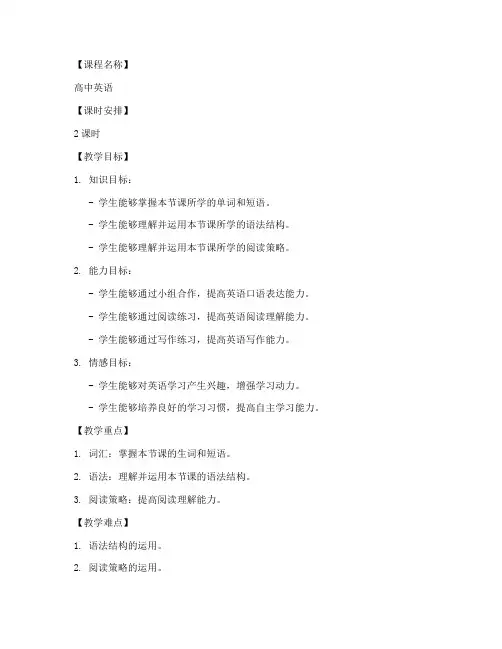
【课程名称】高中英语【课时安排】2课时【教学目标】1. 知识目标:- 学生能够掌握本节课所学的单词和短语。
- 学生能够理解并运用本节课所学的语法结构。
- 学生能够理解并运用本节课所学的阅读策略。
2. 能力目标:- 学生能够通过小组合作,提高英语口语表达能力。
- 学生能够通过阅读练习,提高英语阅读理解能力。
- 学生能够通过写作练习,提高英语写作能力。
3. 情感目标:- 学生能够对英语学习产生兴趣,增强学习动力。
- 学生能够培养良好的学习习惯,提高自主学习能力。
【教学重点】1. 词汇:掌握本节课的生词和短语。
2. 语法:理解并运用本节课的语法结构。
3. 阅读策略:提高阅读理解能力。
【教学难点】1. 语法结构的运用。
2. 阅读策略的运用。
【教学准备】1. 教学课件。
2. 生词卡片。
3. 阅读材料。
4. 写作练习材料。
【教学过程】第一课时一、导入1. 利用多媒体展示与课文相关的图片或视频,激发学生的学习兴趣。
2. 通过提问,引导学生复习上一节课所学的知识点。
二、新课导入1. 介绍本节课的主题和目标。
2. 引导学生通过预习,了解课文的大致内容。
三、词汇教学1. 利用生词卡片,带领学生学习新单词和短语。
2. 通过游戏或活动,让学生在语境中运用新单词。
四、语法教学1. 讲解本节课的语法结构,结合例句进行讲解。
2. 让学生进行语法练习,巩固所学知识。
五、阅读教学1. 引导学生阅读课文,了解文章大意。
2. 通过提问,引导学生分析文章结构和细节。
六、总结1. 回顾本节课所学内容,强调重点和难点。
2. 鼓励学生在课后进行复习和巩固。
第二课时一、复习1. 利用多媒体或板书,复习上一节课所学的词汇和语法。
2. 让学生进行口语练习,提高英语口语表达能力。
二、阅读巩固1. 让学生阅读课文,找出重点段落和细节。
2. 通过小组讨论,让学生分享自己的阅读体会。
三、写作教学1. 引导学生思考本节课的主题,准备写作素材。
2. 讲解写作技巧,如开头、结尾、过渡等。
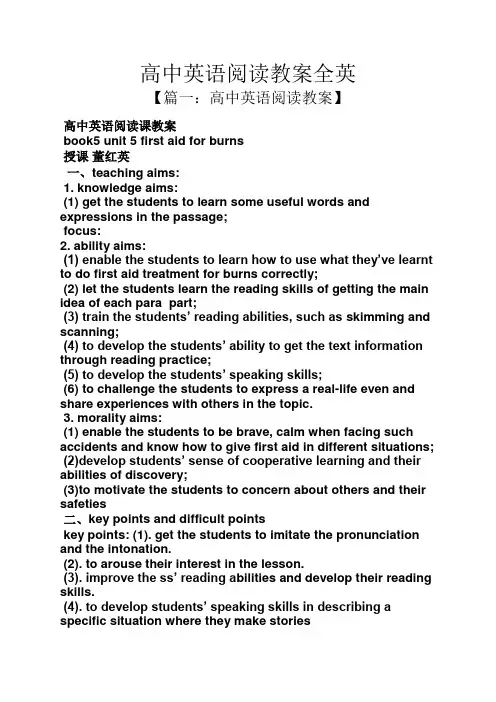
高中英语阅读教案全英【篇一:高中英语阅读教案】高中英语阅读课教案book5 unit 5 first aid for burns授课董红英一、teaching aims:1. knowledge aims:(1) get the students to learn some useful words and expressions in the passage;focus:2. ability aims:(1) enable the students to learn how to use what they’ve learnt to do first aid treatment for burns correctly;(2) let the students learn the reading skills of getting the main idea of each para part;(3) train the students’ reading abilities, such as skimming and scanning;(4) to develop the students’ ability to get the text information through reading practice;(5) to develop the students’ speaking skills;(6) to challenge the students to express a real-life even and share experiences with others in the topic.3. morality aims:(1) enable the students to be brave, calm when facing such accidents and know how to give first aid in different situations;(2)develop students’ sense of cooperative learning and their abilities of discovery;(3)to motivate the students to concern about others and their safeties二、key points and difficult pointskey points: (1). get the students to imitate the pronunciation and the intonation.(2). to arouse their interest in the lesson.(3). improve the ss’ reading a bilities and develop their reading skills.(4). to develop students’ speaking skills in describing a specific situation where they make storieswith the first aid treatment they have learnt in this lesson. difficult points: (1).to improve the ss’ reading abilities and develop their reading skills; .(2). to help the ss use what they’ve learnt to do first aid treatment for burns correctly. (3). to develop students’ speaking skill in describing a specific situation where they makestories with first aid treatment in this lesson.三、teaching procedures:step 1:watching and thinking1. i will begin the lesson by playing a video and help the students to find out “what happened to the boy? what did the man do before a doctor can be f ound?”, which is to lead in the topic: “first aid”, and get the students ready for the further discussion “what is first aid?”. help the students to get the answer “first aid is a temporary form of help given to someone who suddenly falls ill or gets injured before a doctor can be found”, and explain the new word “temporary---lasting or serving for a time only, not permanent”.(2) while helping the students finish all the exercises, i will carry out a competition: divide the students into four groups, and the one who stand up fast and give the right answer can get 1 mark for his\her group, the group which gets the highest mark will get a present.step 2:fast reading1. give the students a minute and some tips to help them divide the passage into 5 parts and find out the main idea of each part.questions:1. how many parts can the passage be divided into?2. what is the main idea of each part?part 1 a. the characteristics of three kinds of burnspart 2 b. the three types of burnspart 3 c. different first aid treatment for different burnspart 4 d. the functions of the skinpart 5 e. how we get burnedstep 3:careful reading1. get the students finish some comprehensive exercises, and help them to get the key information of each part. try to make the students finish these exercises creatively and actively;1). listen to the tape of part1 and find out: the functions of skin1. protect you against poisons and the sun’s harmful rays;2. keep you .4. give you .2). listen to the tape of part2 and find out the causes of burns3). listen to the tape of part3 and find out: types of burnsthere are three types of burns depending on which layers are burned.first degree burns affect only the _____ layer and should feel better within _______________.second degree burns affect both the top and the_______ layer. these burns are serious and take ______________ to heal.third degree burns affect all three layers and any ______ and organs under the skin. they are very severe injuries and the victim must get to hospital at once.4). listen to the tape of part 4 and find out the characteristics of burns5). listen to the tape of part 5 and find out the treatment for first aid1. ________ clothing and jewelry near the burns.2. ______ the burns with cool but not icy water.3. ______ cool, clean wet cloths on the burns.4. ______ the burned area gently.5. ______ the burned area with a dry clean bandage.6. ______ the burned area higher than the heart, if possible.7. ______ the victim to the doctor or hospital, if the injuries are second or third degreeburns.2. get the students to read the passage aloud while they are listening to the tape, ask the students to pay attention to the pronunciation and the intonation;3. guide the students if necessary, and always encourage them, encouragement can build their confidences.step 4:post reading:1. to practise the use of group and pair activities, with the emphasis on communicating with their partners and the cooperation of teams.2. guide the students to find out the correct answer and remind them of paying attention to the key words.(1). the passage is mainly about __________.a. the function of the three layers of the skinb. the characteristics of burnsc. burns and the first aidd. steps of treatment for different burns(2). you can get burns by various things, except __________.a. the sun or hot liquidsb. steam or radiationc. fire or the lightd. electricity or chemicals(3). when you get the second degree burns, you can carry out the following first aid except _______.a. cool the burns immediately with the icy waterb. get a doctor to help you at oncec. place cool cloths on the burned area repeatedlyd. dry the burned area gently3. help the students summarize some useful reading skills.4. to process information and to apply knowledge to solve a problem.step5: conclusion of reading skills1.help the students discover some reading skills through reading a similar passage.2. develop the students’ learning-by-doing abilities【篇二:高中英语阅读教案】英语阅读教案objectives1.to find out some specific facts of the passage2.to study some useful expressions and new words in the text.3.to make up a conversation between marco polo and the author4.to practise writing a reportteaching procedures:step 1 lead-in ( 歌曲导入 )t: good morning , class.ss: good morning , madam .t: today let’s begin our class with the beautiful song “a whole new world”. we have been learning the song these days. now listen , enjoy and learn to sing the song again.step 2 group discussion ( 小组讨论 )t: what is the song about ? what do you think of the song? sa: it’s about a whole new world. ??.sb: it’s beautiful. ??.t: good. now look at the screen. china in the yuan dynasty was a whole new world to marco polo. today let’s read a passage marco polo. have you ever heard of marco polo? do you know kublai ? what do you know about the yuan dynasty?( show the pictures of marco polo and some people in italy, kublai and some people in the yuan dynasty.)t: let’s have group discussion. each group has its own question. group one : who was marco polo? what do you know about marco polo? group two :who was kublai ? what do you know about kublai? group three:what do you know about the yuan dynasty?group four: what do you know about italy?step 3 vocabulary studyt: here are some important words which are frequently used when we talk about marco polo.look them up in the dictionary . write down the sentences and english explanations.faithful / fantastic / imprison / awed / missionstep 4 fast-reading ( 快速阅读)t: now, let’s read the passage marco polo and his travels . read the text as quickly as possible.try to find the answers to the questions on the screen.1.why did marco and his father travel to china?2.why was the emperor impressed with marco?3.why was marco surprised to see people using paper money?4.what were the black stones marco saw people burning for fuel?5.how long did marco spend in china?step 5 听录音、观图像。

英语阅读课的教案范例一、教学目标本节课的教学目标旨在培养学生的英语阅读能力和理解能力,提高他们的词汇量和语法应用能力。
具体目标如下:1.学生能够熟练阅读并理解一篇趣味性的英语短文;2.学生能够通过阅读获得新的词汇和句型,并能够正确运用于实际情境中;3.学生能够运用推理和归纳的能力,整合文章中的信息并回答相关问题。
二、教学重点1.学生能够熟练阅读并理解英语短文;2.学生能够通过阅读获得新的词汇和句型;3.学生能够运用推理和归纳能力整合文章中的信息。
三、教学准备1.教师准备一篇趣味性的英语短文;2.教师准备相关的词汇和句型练习题;3.教师准备几个与文章相关的问题,用于学生的思考和讨论。
四、教学过程步骤一:导入1.向学生介绍本节课的教学目标,并简要解释为什么学习英语阅读是重要的;2.引发学生的兴趣:向学生展示一幅插画,让学生根据插画猜测故事情节。
步骤二:阅读理解1.教师朗读整篇短文,同时向学生展示短文的文字内容;2.学生自主阅读短文,并标注他们认为重要的信息和词汇;3.教师鼓励学生彼此交流,讨论短文内容,解答疑惑。
步骤三:词汇学习1.教师将短文中的生词和短语写在黑板上,并解释其意思;2.学生跟读并积极运用这些词汇和短语造句;3.教师提供相关的练习题,让学生巩固所学词汇和短语的应用能力。
步骤四:再阅读和思考1.学生再次阅读短文,尝试回答教师提出的问题;2.学生可自行思考和整理答案,也可与同学进行群体讨论;3.教师引导学生思考文章中的逻辑关系和引导词语的作用。
步骤五:总结和讨论1.教师与学生一起总结本节课的学习内容和所获得的收获;2.学生可以提出问题和分享自己的思考。
五、课后作业1.学生完成相关的词汇和句型习题;2.学生根据短文内容写一篇简短的读后感,并分享给同学。
六、教学反思本节课通过引导学生阅读一篇趣味性的英语短文,培养了他们的阅读能力和理解能力。
通过词汇学习和思考问题,学生不仅可以掌握新的词汇和句型,还可以锻炼他们的推理和归纳能力。
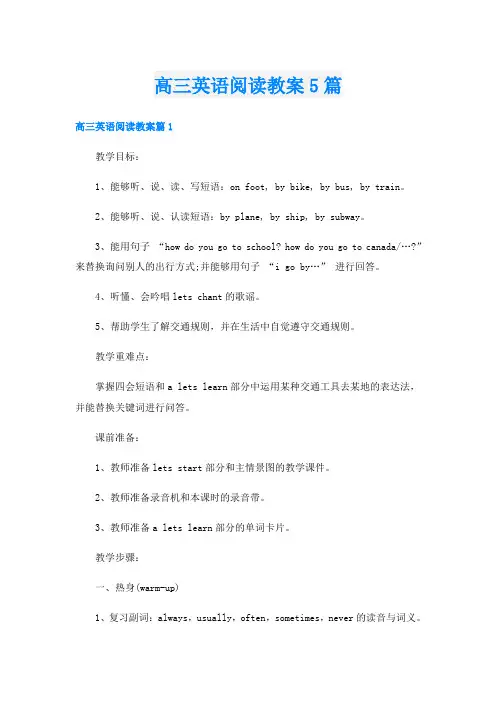
高三英语阅读教案5篇高三英语阅读教案篇1教学目标:1、能够听、说、读、写短语:on foot, by bike, by bus, by train。
2、能够听、说、认读短语:by plane, by ship, by subway。
3、能用句子“how do you go to school? how do you go to canada/…?”来替换询问别人的出行方式;并能够用句子“i go by…”进行回答。
4、听懂、会吟唱lets chant的歌谣。
5、帮助学生了解交通规则,并在生活中自觉遵守交通规则。
教学重难点:掌握四会短语和a lets learn部分中运用某种交通工具去某地的表达法,并能替换关键词进行问答。
课前准备:1、教师准备lets start部分和主情景图的教学课件。
2、教师准备录音机和本课时的录音带。
3、教师准备a lets learn部分的单词卡片。
教学步骤:一、热身(warm-up)1、复习副词:always,usually,often,sometimes,never的读音与词义。
t: when do you get up? / when do you go to school? … (引导学生用always,usually,often,sometimes回答)2、t:today i go to school by bus. i usually go to school on foot. 教师利用肢体动作帮助学生理解句子意思。
t:what about you? do you go by bike or by bus? do you go on foot? or by car? 师生之间自由会话,引出几种常见的交通方式。
引导学生看本课lets start部分的标图并回答问题。
二、预习(preview)1、lets chant教师放本课lets chant部分的录音,唱到on foot时,全班跺跺脚;唱到by car/ bike/ bus/ plane/ train的时候,学生做出相应的动作。
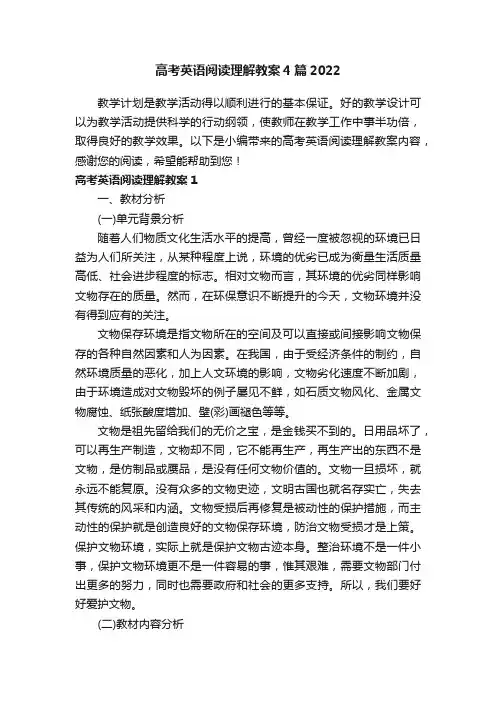
高考英语阅读理解教案4篇2022教学计划是教学活动得以顺利进行的基本保证。
好的教学设计可以为教学活动提供科学的行动纲领,使教师在教学工作中事半功倍,取得良好的教学效果。
以下是小编带来的高考英语阅读理解教案内容,感谢您的阅读,希望能帮助到您!高考英语阅读理解教案1一、教材分析(一)单元背景分析随着人们物质文化生活水平的提高,曾经一度被忽视的环境已日益为人们所关注,从某种程度上说,环境的优劣已成为衡量生活质量高低、社会进步程度的标志。
相对文物而言,其环境的优劣同样影响文物存在的质量。
然而,在环保意识不断提升的今天,文物环境并没有得到应有的关注。
文物保存环境是指文物所在的空间及可以直接或间接影响文物保存的各种自然因素和人为因素。
在我国,由于受经济条件的制约,自然环境质量的恶化,加上人文环境的影响,文物劣化速度不断加剧,由于环境造成对文物毁坏的例子屡见不鲜,如石质文物风化、金属文物腐蚀、纸张酸度增加、壁(彩)画褪色等等。
文物是祖先留给我们的无价之宝,是金钱买不到的。
日用品坏了,可以再生产制造,文物却不同,它不能再生产,再生产出的东西不是文物,是仿制品或赝品,是没有任何文物价值的。
文物一旦损坏,就永远不能复原。
没有众多的文物史迹,文明古国也就名存实亡,失去其传统的风采和内涵。
文物受损后再修复是被动性的保护措施,而主动性的保护就是创造良好的文物保存环境,防治文物受损才是上策。
保护文物环境,实际上就是保护文物古迹本身。
整治环境不是一件小事,保护文物环境更不是一件容易的事,惟其艰难,需要文物部门付出更多的努力,同时也需要政府和社会的更多支持。
所以,我们要好好爱护文物。
(二)教材内容分析本单元话题——文物古迹(Cultural relics )历来是全世界较为关注的焦点之一,尤其是在伊拉克战争中,大量代表古人类文明的文物、古迹惨遭破坏,甚至毁灭!本单元所采用话题构成了一个现代意义十足的时尚理念,能够充分唤起学生的参与欲望。
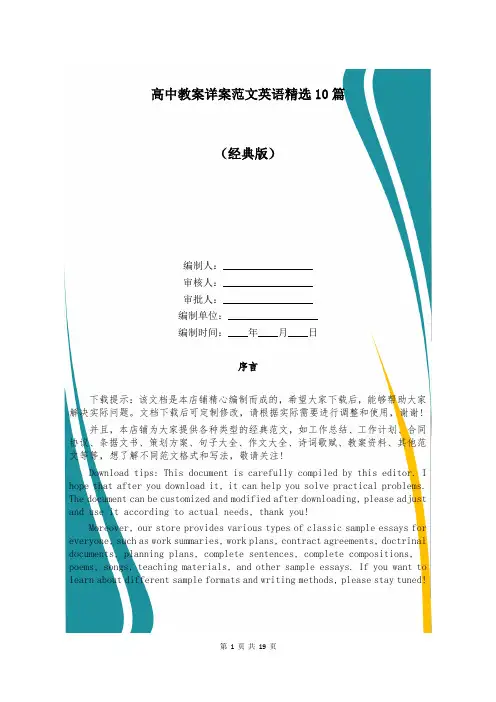
高中教案详案范文英语精选10篇(经典版)编制人:__________________审核人:__________________审批人:__________________编制单位:__________________编制时间:____年____月____日序言下载提示:该文档是本店铺精心编制而成的,希望大家下载后,能够帮助大家解决实际问题。
文档下载后可定制修改,请根据实际需要进行调整和使用,谢谢!并且,本店铺为大家提供各种类型的经典范文,如工作总结、工作计划、合同协议、条据文书、策划方案、句子大全、作文大全、诗词歌赋、教案资料、其他范文等等,想了解不同范文格式和写法,敬请关注!Download tips: This document is carefully compiled by this editor. I hope that after you download it, it can help you solve practical problems. The document can be customized and modified after downloading, please adjust and use it according to actual needs, thank you!Moreover, our store provides various types of classic sample essays for everyone, such as work summaries, work plans, contract agreements, doctrinal documents, planning plans, complete sentences, complete compositions, poems, songs, teaching materials, and other sample essays. If you want to learn about different sample formats and writing methods, please stay tuned!高中教案详案范文英语精选10篇高中教案详案范文英语第一篇I know most of my high school fantasy of XXXcontentXXX is not possible, otherwise it is not called XXXfantasyXXX.Things are always conflict with I XXXthinkXXX, might be gods his old mans house dont let me get it.High school I even very hard tsinghua Beijing university,more dont say XXXones deceased father grindXXX later; The college entrance eXamination after I went to the jiangnan tourism, looking forward to meet in a misty rain.But didnt in this picturesque jiangnan met that my mind think that XXXwomanXXX; Im looking forward to start a company also dont know whether can realize, everything is unknown...高中教案详案范文英语第二篇1.题目:MillenniumKids2.内容Millennium Kids is an international youth empowerment environmental organization.Millennium Kids HQ - Perth Western Australia is a not-for-profit organization headquartered in Perth, Western Australia,began in 1996 after a small group of Western Australian students attended the United Nations ‘Leave It ToUs’ environmental conference for children in the UK.On their return from the conference, the young people were disappointed with the level of youth involvement in local environment issues and decided to set the wheels in motion for developing their own environmental conference –“Kids Helping Kids.With support from Perth Zoo, Department of Environment, Clean Up Australia, CALM and the City of South Perth a conference was born and, subsequently, their own youth-based environmental organization, Millennium Kids Inc.The organization has international affiliates in Canada and South Africa with collaborative organization links in Indonesia and Malaysia.Millennium Kids Australia is a registered charity with taX deductible lennium Kids is run by kids, for kids,aged 10–25 years.A team of educators, mentors and sponsors support their aim to encourage young people to be leaders by being aware and active in their environment.Young people aged 18–25 can progress to leadership and training roles within the organization helping take practical action to improve their local environment.The Millennium Kids agenda is directed by its Youth Board,with fifteen members aged between 10 and 25 years, and issupported by the United Nations Environment Program Agenda 21,Chapter 25 Declaration which states ‘national governments should pay more attention to the opinions and concerns of children regarding the environment’ and how it should be managed for future generations’.3.要求(1)朗读短文(2)设计听力课(3)适当板书设计高中教案详案范文英语第三篇高中英语阅读课文具有题材广泛、体裁各样、语言知识丰富等特征,是各单元教学的核心部分,也是培养学生阅读能力的主要渠道。

英语阅读课教案(5篇范文)第一篇:英语阅读课教案英语阅读课教案模板一、反馈:1.主要是上节课的练习易出错的地方。
want sb.to do, It’s good for sth , be active2.上节的重点知识回顾。
What do you usually do on weekends? I usually play soccer?How often do you watch TV? I watch TV twice a week.二、教学重难点: 1.语法.一般现在时:时间状语:always, usually, often, sometimes, hardly ever, once a week, twice a week, three times a week 2.基本句型: What do you usually do on weekends? I usually play soccer?How often do you watch TV? I watch TV twice a week.)3.长短句子的理解。
1.My health lifestyle helps me get good grades2.Good food and exercise help me to study better.help sb to do sth help sb do sth, help sb with sthnever, 3.I try to eat a lot of vegetables.try to do sth三、突破方法:英语阅读三遍阅读法:(ppt)第一遍学生快读,老师提出1问题。
Q: How often does she eat fruit and drink milk? 第二遍学生细读,老师提4问题。
1.What does she try to eat? 2.How often does she drink coffee? 3.How many hours does she sleep every night?4.What helps her get good grades? 第三遍学生朗读及学生自己提出问题,老师解答疑难。
英语阅读课的教案范例一. 教案概述本教案是针对英语阅读课设计的教学计划,旨在培养学生的英语阅读能力和阅读理解能力。
通过本教案的实施,学生将提高自己的英语阅读技巧,并培养对英语文本的准确理解和分析能力。
二. 教学目标通过本节课的学习,学生将能够:1.提高英语阅读速度和准确度;2.培养对英语文本的理解和分析能力;3.掌握一些常用的阅读技巧,如扫读和略读;4.培养学生的英语阅读兴趣。
三. 教学内容本节课将以一篇短文为基础进行教学,短文内容为生活中常见的话题,如“家庭”。
教师将通过一系列的教学活动和练习引导学生提高英语阅读能力。
四. 教学流程1. 导入(5分钟)•教师简要介绍本课将要学习的主题和目标;•引导学生谈论自己家庭的情况,激发学生对本课话题的兴趣。
2. 预测阅读(10分钟)•教师呈现短文的标题,并让学生根据标题猜测短文的内容;•学生进行小组讨论,分享各自的预测。
3. 快速扫读(15分钟)•教师让学生快速浏览全文,了解短文的大意;•学生回答与短文内容相关的问题,培养学生的扫读能力。
4. 细节阅读(20分钟)•教师引导学生逐段阅读短文,并提出一系列的问题,让学生回答;•学生分组合作,互相帮助理解短文内容。
5. 理解与分析(15分钟)•教师引导学生对短文进行理解和分析,提出一些开放性问题供学生思考和讨论;•学生进行小组讨论,分享自己的观点和答案。
6. 小结与拓展(10分钟)•教师对课堂内容进行总结,强调学生在本节课中学到的重点知识和技巧;•教师布置相关阅读作业,加深学生对英语阅读的训练和应用。
五. 教学方法本节课采用多种教学方法,如导入讨论、小组合作、问题引导等方法,旨在激发学生的英语阅读兴趣,提高他们的阅读能力。
六. 教学评估本节课的教学评估主要通过以下几种方式进行:•学生在课堂上的积极参与程度;•学生在小组讨论和问题回答中的表现;•学生对文章内容的准确理解和分析能力。
七. 教学资源•短文《家庭》(准备足够的复印件供学生使用);•问题练习;•小组讨论指南。
高中英语阅读课优秀教案教案标题:高中英语阅读课优秀教案教案目标:1. 帮助学生提高英语阅读理解能力;2. 培养学生的阅读策略和技巧;3. 培养学生的文化意识和跨文化交际能力。
教学重点:1. 提高学生的阅读速度和准确性;2. 培养学生的阅读理解能力;3. 培养学生的批判性思维能力。
教学难点:1. 培养学生的文化意识和跨文化交际能力;2. 培养学生的批判性思维能力。
教学准备:1. 高中英语教材和相关阅读材料;2. 多媒体设备;3. 学生练习册和作业本。
教学步骤:步骤一:导入(5分钟)1. 创造一个引起学生兴趣的话题,如“世界上最长的河流是什么?”2. 引导学生进行小组讨论,激发学生的思考和好奇心。
3. 提示学生通过阅读来获取答案。
步骤二:阅读前任务(10分钟)1. 展示一段与河流相关的图片或视频,引起学生对话题的兴趣。
2. 提问学生对河流的了解程度,并激发他们提出问题的能力。
3. 分享学生的问题并进行讨论,引导学生思考河流的重要性和影响。
步骤三:阅读活动(20分钟)1. 提供一篇关于世界上最长的河流的阅读材料,要求学生默读。
2. 分发阅读材料的问题,鼓励学生在阅读过程中寻找答案。
3. 学生个人完成问题,并与同桌讨论答案。
4. 邀请几组学生分享他们的答案和理由。
步骤四:阅读后任务(15分钟)1. 分组讨论学生对于河流的看法和观点,并展示给全班。
2. 鼓励学生就河流的重要性和保护提出自己的建议和解决方案。
3. 引导学生思考河流与不同文化之间的联系和交流。
步骤五:拓展活动(10分钟)1. 分发相关阅读材料,让学生自主选择阅读并写下自己的观点和总结。
2. 鼓励学生分享自己的阅读体验和感受。
步骤六:作业布置(5分钟)1. 布置阅读材料的相关作业,如写一篇关于河流的短文或设计一个海报。
2. 强调作业的要求和截止日期。
教学反思:1. 教师在教学过程中要注重激发学生的学习兴趣和积极性,通过多样化的教学活动提高学生的阅读能力。
英语教案阅读课范文全英文版Sure, I will help you write an English essay with the given requirements.Language is a fundamental aspect of human communication, and English has become one of the most widely spoken languages in the world. As a result, the teaching and learning of English has become a crucial focus for educators and students alike. In the context of English language education, the development of effective lesson plans and teaching strategies is essential to ensure that students can effectively acquire and apply the language skills they need to succeed.One of the key components of an effective English language education program is the use of reading comprehension exercises. Reading is a fundamental language skill that allows students to engage with and understand written texts, which is a critical component of language acquisition and communication. By providing students with opportunities to read and analyze a variety of English texts, teachers can help them develop their vocabulary, grammar, and overall language proficiency.When designing an English language reading comprehension lesson plan, there are several key elements that teachers should consider. First and foremost, it is important to select appropriate texts that are relevant and engaging for the target audience. This may involve choosing texts that are aligned with the students' language proficiency level, as well as those that address topics or themes that are of interest to the students.Once the text has been selected, the teacher should develop a structured lesson plan that guides students through the reading and analysis process. This may include pre-reading activities that introduce the text and activate the students' prior knowledge, as well as during-reading activities that encourage close examination of the text's content and structure. Post-reading activities, such as discussion questions or written assignments, can also be used to reinforce the students' understanding and application of the language skills they have developed.Throughout the lesson plan, it is important for the teacher to incorporate a variety of instructional strategies and techniques to engage the students and enhance their learning experience. This may include the use of multimedia resources, such as audio recordings or visual aids, as well as interactive activities that encourage students to actively participate in the learning process.Moreover, the lesson plan should be designed to address the specific language learning needs and goals of the students. This may involve tailoring the content and activities to target particular language skills, such as vocabulary development, grammar usage, or reading comprehension strategies. By aligning the lesson plan with the students' learning objectives, teachers can ensure that the instruction is effective and relevant.In addition to the core components of the lesson plan, it is also important for teachers to consider the overall structure and organization of the reading comprehension unit or course. This may involve developing a coherent sequence of lessons that build upon one another, with each lesson building upon the skills and knowledge acquired in the previous lessons.Furthermore, it is important for teachers to regularly assess the students' progress and adapt the lesson plan as needed to ensure that they are meeting their language learning goals. This may involve the use of formative assessments, such as quizzes or short exercises, as well as summative assessments, such as final exams or projects, to evaluate the students' overall language proficiency.Overall, the development of effective English language reading comprehension lesson plans is a complex and multifaceted process that requires careful planning, implementation, and evaluation. Byincorporating best practices in language instruction and addressing the specific needs and goals of their students, teachers can create engaging and impactful learning experiences that help students develop the language skills they need to succeed in a global, multilingual world.。
英语阅读课文教案范文In this lesson, we will explore the art of reading comprehension through a short story titled "The Enchanted Forest." This narrative is designed to engage students with a vivid imagination and enhance their vocabulary.The story revolves around a young protagonist who stumbles upon a magical forest. Through descriptive language, students will be encouraged to visualize the scene and empathize with the character's sense of wonder and discovery.We will break down the text into smaller sections, focusing on key vocabulary and sentence structure. Students will be tasked with identifying the main idea and supporting details in each paragraph, fostering their analytical skills.To deepen understanding, students will participate in a group discussion, sharing their interpretations of thestory's themes and moral lessons. This collaborative approach encourages active listening and critical thinking.In the final activity, students will be asked to write a short reflection on what they have learned from the story. This exercise not only reinforces comprehension but also allows for personal expression and creativity.By the end of this lesson, students should have a greater appreciation for the power of storytelling and the joy ofreading. They will leave with a newfound confidence in their reading skills and a curiosity to explore more literary adventures.。
高三英语阅读教案范文集锦教案可以恰当地选择和运用教学方法,调动学生学习的积极性,面向大多数学生,同时注意培养优秀生和提高后进生,使全体学生都得到发展。
以下是小编带来的高三英语阅读教案内容,感谢您的阅读,希望能帮助到您!高三英语阅读教案1以教学大纲,考试说明为依据,以课程标准为准绳,以人教版新课标教材为依托和基础,制定全面的、科学的、系统的、针对性强的复习计划,来充分提高学生的英语基础水平。
并且密切关注今年的高考动态,联系学生的实际情况,充分发挥学生潜能,学生非智力因素,调动学生学习积极性,扎扎实实抓好双基,通过综合训练,培养学生运用知识的能力,努力提高学生的综合素质和解题技巧,以适应新的高考形式和要求。
本届学生虽然已经经过两年的高中英语训练,但情况仍不容乐观,基础不够扎实,完形填空,阅读理解,改错和书面表达等综合能力堪忧,所以在对学生全面强化督促的同时,如何抓好基础,强化针对性,有的放矢提高讲和练的方法及效益,成为专项与整体复习中的一大挑战。
第一轮复习:本学期争取完成高中8册书的复习,根据每册课文知识点进行复习,且进行词汇复习,为第二阶段复习打好基础。
且每两周进行一次测试.资料采用高中新课标《学案与测评》及其配套练习、《维克多英语听力》、人教版新课标教材必修1——5以及选修6——8、2011年全国各地的高考试题教学安排与措施:1.抓好词汇复习词汇是高中英语最基本的要素,它好比是人身体上的肉,而语法是人身体上的骨骼,两者一起组成了人体,所以高中英语复习关键是词汇复习。
2.夯实语法知识的基础,并作进一步的提高。
对学生进行语法专项指导,各个击破,一一掌握。
并加以单项选择的解题技巧,提高学生分析问题和解答问题的能力。
3.听力训练常抓不懈高考英语听力分值是30分,这在试卷中占了相当大的比例。
要得高分,这就要求学生平时多练习英语,多做听力练习,多听多看英语广播电视节目。
每天晚自习和周五的早自习进行20分钟左右的听力训练,并对学生提出一定的要求,平时也要求老师上课尽量用英语讲课,来创造一个听的语言环境。
高三英语阅读教学案例第一篇:高三英语阅读教学案例高三英语教学案例--人教版选修九Unit one Breaking records The Road is always ahead of you Part 2高三英语课堂教学设计案例张瑞利郑翠云(高三选修九U1 Breaking the record 第二课时阅读课)一.教学设计背景(1)教学设计理念1、运用任务型语言教学模式,训练培养学生对语言的综合运用,实现目标,感受成功,教学进度整体把握,教学形式不拘一格。
2、课堂以学生为主体,以任务为主线,重视体验参与,教师起到“设计者、研究者、促进者、协调者”的作用。
3、在教学中,突出交际性,注重读写的实用性,要进行情感和策略调整,以形成积极的学习态度,促进语言实际运用能力的提高。
4、课后访谈调查,读写摘记,重视语言运用。
5、正视个体差异,倡导过程激励,以多层次、多角度、多主体的结果与过程并重的评价方式激励进步。
(2)学情分析一方面,高中年龄段的学生对周围的事物较为敏感,有自己的观点和看法,他们不满足于教科书上的知识,想获得更多的信息。
而对于高三的学生来说。
更要在有限时间内获得最高的学习效率。
在英语学习上,他们不只是想把英语作为一门死记硬背的课程来学,更希望能学到知识性和趣味性兼有的内容,从英语学习中获得更多的知识和能力。
另一方面学生对体育比较感兴趣,对吉尼斯纪录有一定的了解因此,应结合学生的实际情况,因材施教,激发学生兴趣,让学生主动学习,学有所获。
二.教学主题(1)教学内容分析1.知识背景及新课程、新教材本单元以世界纪录为中心话题,只要内容涉及以阿里西塔福尔曼为代表的几个世界吉尼斯纪录的保持者及其运动经历,重点讨论了创造吉尼斯纪录所必备的身体素质、心理素质、创新意识以及挑战自我的决心和毅力。
本单元的语言和技能目标都是围绕这一中心展开的。
本节课是是本单元第二课——“阅读课”,也是本单元的重点。
文章的主题是“路永在前方”其内容介绍了世界吉尼斯的保持者阿西里塔福尔曼,他不是职业运动员,但其运动成就让许多运动员望尘莫及,本节课通过阿里西塔福尔曼的成长经历以及获得这些成就的精神动力,激励学生认识自我的潜力,找到精神动力的源泉,实现梦想。
高三英语阅读课教案范文集锦高三英语阅读课教案1一个完整的教学活动在写好一篇优秀的教案后就完成了一半,说到了教案的设计,我们就要知道一篇完整的教案至少应该包括教学目标,教学重难点,教学方法,以及最重要的部分教学过程。
英语的教学目标分为三维目标,即知识目标(knowledge aim)、技能目标(ability aim)和情感态度价值观目标(emotional aim)。
阅读课是高中英语占比重的课型,对于高中生应该掌握的英语语言基础知识包括语音、词汇、语法和话题等五方面的内容,所以知识目标我们可以从这5方面进行思考。
能力目标的书写则应该从语言技能,即听说读写这四个方面的技能以及这四种技能的综合运用进行书写。
而情感态度目标,我们则可以从兴趣、动机、自信、意志和合作精神这些方面切入,也可以考虑在学习过程中学生逐渐形成的国际意识和国际视野。
接下来就是教学重难点的书写,教学重点是编写教案的主要内容之一,书写教学重点要求我们队教材进行充分的了解和分析,从本节课的教学目标教学要求出发进行书写,一般是本节课的核心内容。
教学重点不同于教学难点,教学的难点是指学生较难理解或容易产生错误的那部分教材内容。
一般来说常见的教学难点包括抽象而难以理解的知识,内容相近、相似并容易产生混淆容易发生误解的知识。
明确了教学目标和教学目标和教学重难点,还要辅助恰当的教学目标来达到预期的教学效果,对于一些常用的教学方法大家平时都有所接触,这里就不再详细的介绍,但是要告诉大家,教学方法的选择要注意全面、综合的考虑教学目标、教学任务、教学内容。
学生的水平以及自身的教学特点。
教师的教学艺术在很大的程度上取决于其教学方法运用的是否合适、得当。
因此早选择教学方法时要与自己的教学实际相统一。
在教学目标,重难点,教学方法逐一完成以后就进入到了教案设计的重头戏,教学过程的设计,我们来突出讲解一些在高中英语中占比例比较大的课型,阅读课。
在设计教学过程时有很多可操作的方法,但是对于高中英语而言,更好我们把控的一种设计方法就是按照PWP的形式进行书写。
什么是PWP模式,即把阅读课分为前中后三个部分,读前,读中和读后。
非常符合我们的教材设计思路和教学思路。
读前的活动是与阅读内容息息相关的,是对文章的一个预测,激发背景知识的过程。
基于此,读前内容的设计不能脱离文本,要注意背景知识的扩充和对阅读文本的牵引。
读中的过程是让学生完成教学目标实现教学重点,突破教学难点。
对于阅读课而言,学生除了需要理清文章的脉络,了解文章大意还要理解文章的内涵,体会词句,对文章有更细致的了解。
阅读后既是语言知识学习的过程也是交际活动进行的过程,这样呢能够加深学生对于文章的理解也能够锻炼学生的语言运用能力。
这样我们的主要阅读活动就完成了。
一篇好的教案是无数次模拟演练,无数次改动成就的。
所以想要写好教案,还需要大家进行揣摩和练习,只有不断的发现问题和改正问题,才能让一篇教案尽善尽美,希望大家都能够结合讲解的知识写出适合自己教学风格的优秀教案。
高三英语阅读课教案2一、单元考点提示1.单词willing ,devote,cure,disadvantage,shock,institute,admire,debt,expedition, merchant, exist,chart,botany,disaster,crew.2.短语devote。
to 把。
用在;把。
献给succeed in (干)。
成功give off 发出(光、热等)in honour of 为了纪念。
;为向。
表示敬意above all 首先;首要set off 使爆炸;引起;出发pay off 偿清(欠款等)at sea 在大海上;在航海take。
by surprise 使。
吃惊;出奇兵攻占in charge of 主管;负责set out 出发;开始in search of 寻找3.句型(1)I’m (not)sure。
I’m not sure whether/if。
(2)I doubt if/whether。
(3)Making a map of the east coast was an important job.(4)The men often fall ill and suffer fever.(5)They will provide us with eggs and meat.4.交际英语(1)I doubt if he’ll be asked to speak again next year.(2)Perhaps I’ll go to that one.(3)Maybe it was useful for some people.(4)How did you find the talk this morning?(5)I shall insist on leaving at 7 a.m.sharp.(6)We’ve decided to do sth./that。
(7)Have you decided which boat to take?(8)I suggest doing sth.二、考点精析与拓展1.have something(nothing,much,little)to do with与。
有(没有,有很大,有一点)关系。
①I have nothing to do with that young man.②His job has something to do with telephones.③This has little to do with what we are talking about.④Do you have anything to do with that club?2.doubt v. n.怀疑,不相信n.of。
对。
(抱)怀疑或悲观(态度)doubt 从句在否定句及疑问句中多跟that引起的从句,在肯定句中多跟whether(if)引起的从句。
①I doubt the truth of this report.②They have never doubted of success.③I don’t doubt that you are honest.④Can you doubt that he will win?⑤I doubt if that was what he wanted.该词作名词时有以下短语beyond(all)doubt毫无疑问;in doubt怀疑,犹豫,不肯定;no doubt 肯定地,想必;without doubt毫无疑问,一定地①The truth of the story is beyond doubt.②I was in doubt about what to do.③No doubt I learned a lot from that lecture.④Without doubt these theories were all wrong.3.How do (did )you find。
?(你觉得/认为。
怎么样?)是征求对方对某人、某事的看法或意见的用语。
回答时在find 后要跟复合宾语。
How did you find the dishes?(I found them)Tasteless.How do you find Peter Gray?I found him dishonest.4.admit vt.①接纳,许可。
进入(allow sb./sth.to enter)He was admitted to the school this year.Only two hundred boys and girls are admitted to our school every year.②承认,后可接名词,doing、从句或复合结构。
I admit my fault.She admitted having read the letter.He admitted that his prehension was weak.You must admit the task to be difficult.5.be remembered as。
作为。
而被人们怀念He will always be remembered as a national hero.6. ( be)determined to do sth.下定决心做。
determine to do sth.决定(心)做。
①I was determined not to follow their advice.②I left him,determined never to set foot in that house again.③She determined to go that very afternoon.7.certain某(些),仅作形容词用法。
①He didn’t e for a certain reason.②A certain person called on me yesterday.③She will do it on certain conditions.some 也可以作此意讲,但前面无冠词①He is living at some place in East Africa.②I’ve read that story before in some book of other.8.succeed in sth.(doing sth.)(干。
)成功,其反义词组;fail in sth.(doing sth.)或fail to do sth.;名词success;形容词successful9.give off,放出(光、烟、气味等)、散发,give out,放出,发出(声音,光线,气味等),(食物、燃料、力量等)用尽、筋疲力尽。
①These red roses give off a sweet smell.②This device gives out flashes of light in the fog.③Both my strength and money gave out.10.in honour of sb.(sth.) 为了纪念或表示敬意而举行某活动。
①A memorial meeting was held in his honour.②It is only a dance in honour of my birthday.11. devote。
to。
把。
献给,把。
用在devote oneself to。
致力于,献身于be devoted to。